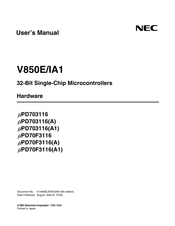NEC UPD703116 Manuals
Manuals and User Guides for NEC UPD703116. We have 1 NEC UPD703116 manual available for free PDF download: User Manual
NEC UPD703116 User Manual (826 pages)
32-Bit Single-Chip Microcontrollers
Brand: NEC
|
Category: Microcontrollers
|
Size: 4.59 MB
Table of Contents
-
-
Features48
-
Image60
-
Memory Map62
-
Area63
-
Cautions98
-
-
-
Features100
-
Bus Control Pins100
-
Bus Access106
-
Bus Width108
-
Wait Function114
-
Function Outline118
-
Bus Hold Timing119
-
Program Space120
-
Data Space120
-
-
-
Features127
-
Configuration128
-
Transfer Mode142
-
Transfer Types145
-
Transfer Target146
-
DMA Transfer End150
-
Precautions154
-
-
-
Features156
-
Operation161
-
Restore163
-
Operation165
-
Restore167
-
Operation186
-
Restore187
-
Exception Trap189
-
Debug Trap191
-
-
-
Features197
-
Configuration197
-
Direct Mode198
-
PLL Mode198
-
PLL Lockup203
-
Overview204
-
HALT Mode210
-
IDLE Mode212
-
-
-
Timer 0218
-
Operation250
-
Operation Timing284
-
Timer 1293
-
Operation313
-
Timer 2326
-
Operation352
-
Timer 3373
-
Operation385
-
Precautions398
-
Timer 4399
-
Control Register404
-
Operation405
-
Precautions407
-
Overview408
-
Control Register409
-
-
-
Features410
-
Features411
-
Configuration412
-
Operation422
-
Precautions441
-
Features442
-
Configuration443
-
Operation455
-
Synchronous Mode464
-
Features477
-
Configuration477
-
Operation493
-
Output Pins508
-
-
-
Configuration514
-
Mask Function523
-
Protocol525
-
Message Formats526
-
Functions535
-
Bit Stuffing535
-
Multi-Master535
-
Multi-Cast535
-
Operations596
-
Transmit Setting609
-
Receive Setting610
-
CAN Sleep Mode612
-
CAN Stop Mode613
-
Burst Read Mode620
-
Cautions on Use623
-
-
Pd70F3116)625
-
Overview625
-
NBD Function630
-
-
-
Features642
-
Configuration642
-
-
-
-
Features719
-
Pin Functions719
-
Initialization721
-
-
-
Pd70F3116)727
-
Features727
-
Pin Connection731
-
VPP Pin731
-
RESET Pin733
-
NMI Pin733
-
Port Pins733
-
Power Supply734
-
Area Number746
-
Advertisement
Advertisement
